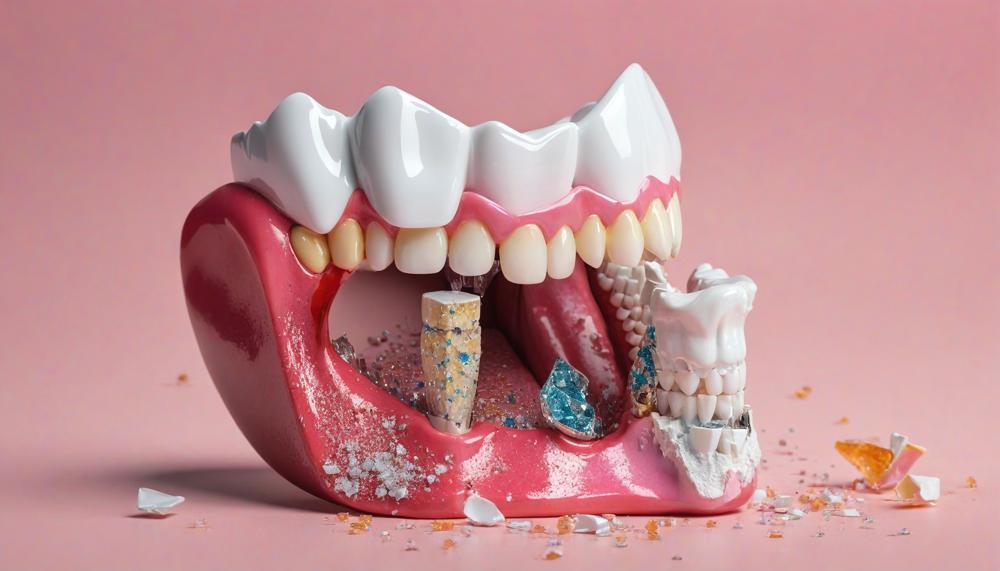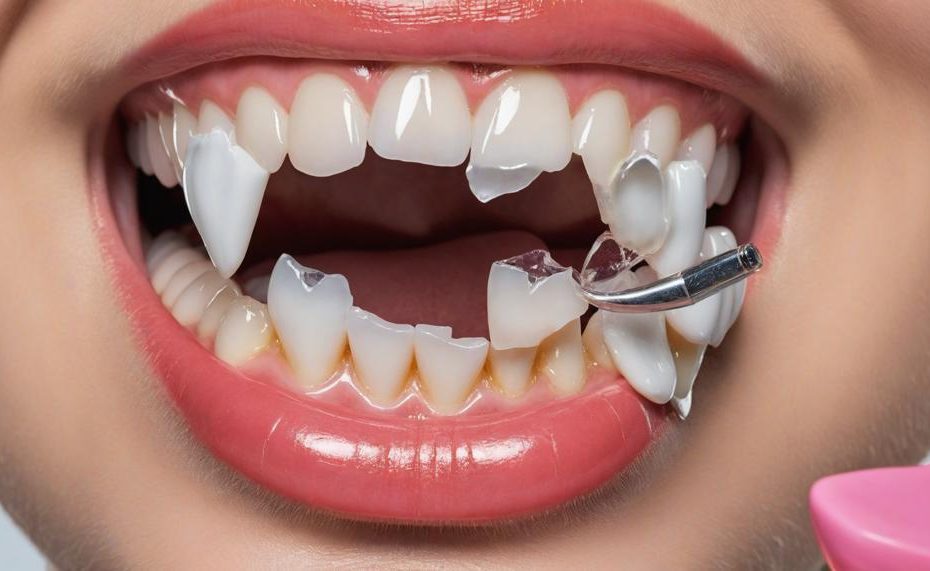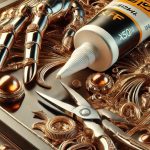Cracked, chipped, or broken teeth can be a real nightmare, both functionally and cosmetically. While a quick fix with a household adhesive like Krazy Glue might seem tempting, it’s crucial to understand the risks and potential consequences of this DIY approach. The short answer is no, you should never use Krazy Glue or any other non-medical adhesive on a broken tooth.
Here’s why:
- Krazy Glue and similar adhesives are not designed for oral use and can be toxic, potentially causing tissue damage, infections, and other health issues when ingested or exposed to the mouth.
- These adhesives lack the necessary durability and may not effectively bond with the tooth structure, leading to further breakage or displacement of the repair.
- Using Krazy Glue can interfere with proper dental treatments and delay seeking professional care, potentially exacerbating the problem.
Key Takeaways:
- Household adhesives contain harmful chemicals not meant for oral exposure.
- They provide a temporary and unreliable fix that can lead to complications.
- Professional dental treatments, such as bonding, veneers, or crowns, offer safe, long-lasting, and aesthetically pleasing solutions.
- Seeking prompt dental care is crucial for maintaining oral health and preventing further damage.
When it comes to broken teeth, the potential risks of a DIY fix far outweigh any perceived convenience. Trust the experts and schedule an appointment with your dentist for proper evaluation and treatment. Your oral health is too valuable to gamble with a risky, short-term solution.
Table of Contents
What is dental glue?
Dental glue, also known as dental cement or tooth glue, is a biocompatible adhesive explicitly designed for dental applications. It is used by dentists to secure dental restorations such as crowns, bridges, inlays, and onlays to damaged or decayed teeth.
When a tooth is chipped, cracked, or broken, dental glue can be used to temporarily bond the broken piece back in place until a permanent restoration can be placed. However, it is crucial to note that over-the-counter dental glue is only intended for very short-term use and should not be considered a long-term solution.
For a broken tooth, the dentist will clean and prepare the area, apply a conditioning agent, and then use a specialized dental adhesive to bond the broken piece back to the tooth or attach a temporary crown or filling. This provides a protective seal and restores the tooth’s function and appearance until a permanent repair can be made.
It is essential to seek professional dental care for a broken tooth rather than attempting a DIY fix with household adhesives like Krazy Glue. These products are not designed for oral use, lack biocompatibility, and can potentially cause further damage, infections, or interfere with future dental treatments.
Dental glue used by professionals is safe, durable, and specifically formulated to bond with tooth structure. It is an integral part of many dental procedures, ensuring a secure and long-lasting bond between the restoration and the natural tooth.

While over-the-counter dental glue can provide a very temporary solution for a broken tooth in an emergency, it should only be used as a stopgap measure until proper dental treatment can be obtained. Neglecting professional care for a broken tooth can lead to further complications and potentially more extensive and costly repairs in the future.
How does dental glue work?
Dental glue, a meticulously formulated adhesive, orchestrates a remarkable symphony to mend fractured teeth. Its composition harnesses the potent forces of compression, chemical bonding, and meticulous application to restore a tooth’s structural integrity and aesthetic allure.
When a tooth succumbs to the ravages of trauma or decay, dental glue emerges as a valiant ally, temporarily binding the fractured segments together. This intricate process commences with the delicate application of the adhesive onto the affected area, ensuring a seamless union between the disparate pieces.
As the glue cures, its unique properties come into play. The compressive force exerted by the adhesive creates an intricate lattice, intertwining the tooth fragments in a harmonious embrace. Simultaneously, the chemical bonds forged within the glue’s molecular structure solidify this intricate tapestry, rendering the once-broken tooth a fortified bastion.
Yet, dental glue’s prowess extends beyond mere structural reinforcement. Its meticulous formulation allows it to mimic the natural translucency and hue of teeth, camouflaging the once-evident fracture lines with a seamless aesthetic. This harmonious blending ensures that the repaired tooth regains its radiant smile-worthy appearance, restoring both form and function.
Furthermore, dental glue’s versatility transcends its role as a temporary fix. It serves as an indispensable ally in securing dental restorations, such as crowns and bridges, ensuring their steadfast adherence to the underlying tooth structure. This unwavering bond not only enhances the longevity of the restoration but also safeguards the patient’s oral health.
While dental glue’s restorative powers are undeniable, its true triumph lies in its ability to provide a respite – a sanctuary of stability and comfort until permanent solutions can be implemented. It is a testament to the ingenuity of modern dentistry, a bridge between the present and the future, ensuring that each smile remains radiant and every bite remains effortless.
Types of dental glue: permanent vs temporary
The difference between permanent and temporary dental glue lies in their intended use and durability. Here are the key distinctions:
| Characteristic | Permanent Dental Glue | Temporary Dental Glue |
|---|---|---|
| Purpose | For long-term restorations like crowns, bridges, and permanent fillings | For temporary fixes, such as holding a broken tooth fragment in place until a permanent restoration can be done |
| Durability | Designed for lasting adhesion and strength | Less durable, intended for short-term use (typically 3-6 weeks) |
| Bond Strength | Forms a strong, long-lasting bond with tooth structure | Weaker bond strength, not meant for permanent use |
| Recommended Use | For permanent dental restorations and repairs | For temporary restorations or short-term fixes before a permanent solution |
For a broken tooth, a permanent dental glue is recommended for the long-term restoration. This type of glue forms a durable bond with the tooth structure, ensuring a strong and lasting repair. Temporary glue may be used as an interim measure to stabilize the tooth until a permanent restoration can be completed, but it should not be relied upon as a long-term solution.
It’s crucial to seek professional dental care for a broken tooth, as attempting a DIY repair with household adhesives like Krazy Glue can lead to further damage, infection, and complications.
Types of dental glue: composition
Dental glue, also known as dental cement, is a specialized adhesive material used by dentists to bond dental restorations like crowns, bridges, and veneers to the natural tooth structure. The main ingredients and their functions in bonding a broken tooth are as follows:
| Ingredient | Function | Description |
|---|---|---|
| Polymers | Provide adhesion | Polymers like methacrylates, epoxy resins, or polycarboxylates form the base of dental glue and create a strong bond between the restoration and tooth. |
| Initiators | Start the curing process | Initiators like benzoyl peroxide or camphorquinone trigger the polymerization reaction, allowing the glue to harden and set. |
| Fillers | Enhance strength and durability | Fillers like glass particles, silica, or zirconia reinforce the glue and improve its mechanical properties. |
| Coupling agents | Promote chemical bonding | Agents like silane or phosphate esters create a strong chemical bond between the glue and the tooth or restoration surface. |
The bonding process typically involves pre-treating the tooth and restoration surfaces to enhance adhesion, applying the dental glue, and then curing (hardening) the glue using visible light or chemical activation. The glue forms a durable, long-lasting bond that secures the restoration in place and restores the function and appearance of the broken tooth.
It’s crucial to note that dental glue is a specialized product designed for oral use and should only be applied by a qualified dental professional.
How do dentists choose dental glue?
When choosing the appropriate dental glue for fixing a broken tooth, dentists consider several crucial factors. Here are the key considerations:
| Factor | Description |
|---|---|
| Bonding Strength | Dentists evaluate the bonding strength of the glue to ensure a secure and long-lasting attachment between the restoration and the tooth structure. |
| Longevity | The expected lifespan of the dental glue is an important consideration, as some glues are designed for temporary fixes, while others offer a more permanent solution. |
| Aesthetic Requirements | For visible areas, dentists prioritize glues that provide a natural-looking finish and match the color of the surrounding teeth for an aesthetically pleasing result. |
| Biocompatibility | Dental glues must be biocompatible and non-toxic to ensure patient safety and prevent adverse reactions. |
| Curing Time | The curing time of the glue, which refers to the time it takes to set and harden, is considered to ensure efficient treatment and patient comfort. |
| Moisture Tolerance | Dentists assess the glue’s ability to bond effectively in a moist oral environment, as moisture can affect the adhesion process. |
By carefully evaluating these factors, dentists can select the most suitable dental glue for each patient’s unique needs, ensuring a successful restoration and a long-lasting, comfortable, and aesthetically pleasing outcome.
Application techniques
Using Krazy Glue, a cyanoacrylate adhesive, on a broken tooth is strongly discouraged. Cyanoacrylate adhesives are not designed for dental use and can pose serious health risks if ingested or exposed to the sensitive tissues of the mouth. Instead, seeking professional dental treatment is highly recommended for repairing a broken tooth. Here are the proper techniques for addressing a broken tooth:
| Step | Description | Precautions |
| Rinse and Clean | Gently rinse the mouth with warm water to remove any debris or food particles from the broken tooth area. | Avoid swallowing any tooth fragments or applying pressure, as it may cause further damage. |
| Apply Cold Compress | If there is swelling or pain, apply a cold compress to the affected area to reduce inflammation and discomfort. | Do not apply the compress directly to the broken tooth, as it may cause further damage. |
| Seek Dental Treatment | Contact your dentist immediately to schedule an appointment. They may recommend dental crowns, bonding, or other restorative procedures based on the extent of the damage. | Avoid using over-the-counter adhesives or glues, as they can cause further damage and potential health risks. |
It’s crucial to seek professional dental care promptly, as attempting to repair a broken tooth with non-dental adhesives like Krazy Glue can lead to infections, tooth loss, and other severe complications.
Can you use super glue on your teeth?
| No, it is not safe to use super glue on a broken tooth. | Super glue, or cyanoacrylate adhesive, is not designed for use in the mouth and can be toxic if ingested. | It may also cause further damage to the tooth structure and surrounding gums. |
| While super glue can be used as a temporary fix for a broken denture, it should never be used on natural teeth. | Crowns that come off due to trauma can be re-cemented by a dentist using FDA-approved dental cement, but attempting to glue a broken tooth yourself with super glue is not recommended. | The root cause of the break needs to be evaluated by a professional to prevent further damage and ensure proper treatment. |
| If you have a broken tooth, it is crucial to seek professional dental care as soon as possible. | Attempting to repair a broken tooth with super glue or any other non-dental adhesive can lead to infections, further tooth damage, and potentially serious health complications. | A dentist can properly evaluate the situation, provide appropriate treatment options, and ensure the long-term health and integrity of your teeth. |
While super glue may seem like a quick and easy fix, it is not safe or recommended for use on broken teeth. Seeking prompt professional dental care is the only way to properly address a broken tooth and prevent further complications.
Conclusion
A broken tooth demands swift action, but reaching for that Krazy Glue tube? That’s a surefire path to an oral health calamity. While the allure of a quick fix is undeniable, the risks far outweigh any perceived convenience. Household adhesives like Krazy Glue harbor toxic chemicals never intended for the delicate ecosystem of your mouth. One wrong move, and you’ve opened the door to infections, tissue damage, and a world of discomfort.
But there’s a better way – a symphony of expertise and precision that modern dentistry offers. Professional dental treatments, meticulously crafted with biocompatible materials, provide the lasting solution your smile deserves. From bonding to crowns, these restorations don’t just patch the problem; they harmonize form and function, fortifying your tooth’s structure while restoring its natural radiance.
So, when that dreaded crack or chip strikes, resist the urge for a DIY fix. Your teeth are precious gems, deserving of the masterful care only a dental professional can provide.






